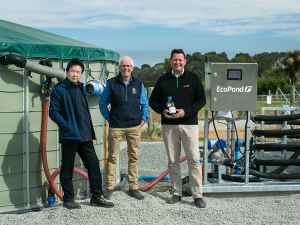Well-placed to weather conflicts
Shipping disruption caused by Houthi rebels in the Red Sea has so far not impacted fertiliser prices or supply on farm.
 Lincoln University professors Hong Di, left, and Keith Cameron with Ravensdown's Carl Ahfield. The team responsible for the Cleartech effluent management system has now unveiled EcoPond, claimed to be a breakthrough in methane mitigation. Supplied. Tony Stewart/Photoshots
Lincoln University professors Hong Di, left, and Keith Cameron with Ravensdown's Carl Ahfield. The team responsible for the Cleartech effluent management system has now unveiled EcoPond, claimed to be a breakthrough in methane mitigation. Supplied. Tony Stewart/Photoshots
Ravensdown has unveiled new methane mitigating technology that it claims virtually eliminates the methane emitted from effluent ponds.
Ponds are the second largest source of methane on a dairy farm – behind direct emissions from the animals themselves. Ravensdown says its Eco- Pond system could cut total farm emissions by 4% to 5%.
It also reduces odour and risk of phosphate loss from pond effluent when spread on farm.
EcoPond was unveiled recently at Lincoln University’s Dairy Research Farm. It is an offshoot of Ravensdown’s award-winning ClearTech effluent recovery system and was developed in conjunction with the same team of Lincoln University’s Professor Hong Di and Emeritus Professor Keith Cameron.
The automated “plug and play” in-line system can be retrofitted to existing ponds and uses the same ferric sulphate additive as ClearTech, metered into the pond by a computer-controlled pump and mixing system.
Cameron says the larger the pond, the more micro-organisms there are in the pond to generate methane.
“This new system has been tested in the lab and at farm scale, where it proves enormously effective at essentially nullifying the methane-creating process.”
Di adds that EcoPond reduces the risk of Dissolved Reactive Phosphate loss to water by up to 99%.
The EcoPond is available for farmers to use now. Ravensdown general manager innovation and strategy Mike Manning says the New Zealand dairy sector is already a world leader in carbon emissions efficiency, but the country has set a 10% target of biogenic methane reduction by 2030.
“This new tool in the farmer’s toolbox has the benefit of robust science behind it and will assist farmers who want to start tracking towards that target now,” he says.
South Waikato farm manager Ben Purua’s amazing transformation from gang life to milking cows was rewarded with the Ahuwhenua Young Maori Farmer award last night.
Bankers have been making record profits in the last few years, but those aren’t the only records they’ve been breaking, says Federated Farmers vice president Richard McIntyre.
The 2023-24 season has been a roller coaster ride for Waikato dairy farmers, according to Federated Farmers dairy section chair, Mathew Zonderop.
Ministry for Primary Industries (MPI) director general Ray Smith says job cuts announced this morning will not impact the way the Ministry is organised or merge business units.
Scales Corporation is acquiring a number of orchard assets from Bostock Group.
Family and solidarity shone through at the 75 years of Ferdon sale in Otorohanga last month.

OPINION: This old mutt well remembers the wailing, whining and gnashing of teeth by former West Coast MP and Labour…
OPINION: Your canine crusader gets a little fed up with the some in media, union hacks, opposition politicians and hard-core…